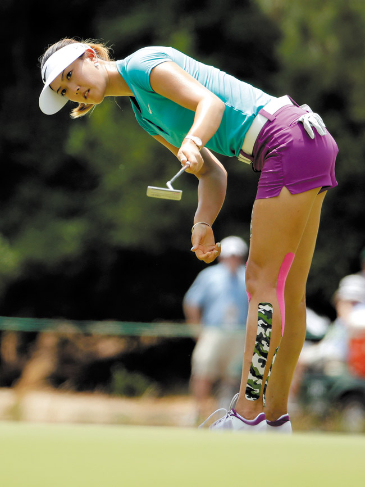What’s On Michelle Wie’s Legs
Whether or not you’re a golf fan, you probably have seen pictures of Michelle Wie winning the U.S. Women’s Open golf tournament last weekend in Pinehurst, N.C.
There she was, showing good form with her long, toned legs partially covered with brightly colored kinesiology tape (also commonly called kinesio tape or KT tape). It’s not the first time we’ve seen a top athlete sporting kinesio tape, but it’s a trend that seems to be spreading with athletes of all levels.
mw-otm-070214-wie2
You may remember Olympic gold medalist Kerri Walsh giving kinesio tape a lot of exposure at the Summer Olympics in 2004. “It really caught fire in the U.S. back then,” recalls UH assistant athletic trainer Jayson Goo. “But earlier than that, when David Beckham was with Real Madrid, he took his shirt off and had some kinesio tape on his ribs in Europe, and that’s when it got real popular. And before that, the first time it was really seen was in 1988, when the Japanese national volleyball team wore it in Korea.”
Goo, who has been at UH for 30 years and a certified kinesio tape instructor for 17 years, cautions that while there’s a growing interest in kinesio tape by the general public, it is best to find someone who’s trained in the application of the tape. He usually holds a seminar once a year for therapists (such as physical, massage, occupational and movement therapists, etc.), as well as athletic trainers, doctors and nurses.
“If you look at Michelle Wie’s taping, her tape was put on a very particular way to help with the problems she was having,” he explains. “There are different brands that you can buy at various sports stores — it’s kind of everywhere now — and they come with instructions. But, if you have somebody who applies it who knows the proper way to tape and what you’re trying to accomplish with the tape, the results are going to be a lot better. If not, you may not perform as well as you would if you put it on correctly.”
The kinesio taping method Goo uses is of Kinesio Tex Tape inventor Dr. Kenzo Kase, a Japanese chiropractor who created the tape in 1973 as a way to prolong the effects of physiologic work done. It’s used by not just athletes, but also nonathletes, including neurological and post-stroke patients.
“How it works is the kinesio tape creates some space between the skin and muscles, which helps with lymphatic flow, lymphatic drainage and increases circulation to that area,” explains Goo. “People most commonly use it for muscle soreness. It helps them recover faster because you have better circulation in that area.
“Also, it can influence the neural or fascial system to stay in the proper position. There are several different things you can accomplish, depending on how the tape is applied.”
Kinesio Tex Tape is made of elastic cotton fibers, contains no medication, and is latex-free and hypoallergenic. It has an acrylic heat-activated backing, and is designed to stretch 40 to 60 percent of its resting length.
At UH, Goo says they’ve been using kinesio tape for 17 years, such as on basketball player Carl English, when he was coming back from a sprained ankle. “At first, we put it on to help with the recovery from surgery and the swelling of the ankle,” he says. “Next, we put it on to help establish his muscle control and for posture.
“We also use it on a lot of soccer players (including Natasha Kai), basketball players and women’s volleyball players. For volleyball and baseball, it’s mostly for rotator cuffs. And a lot of shin splints for the track team. It’s a pretty common usage here.”
There’s a wide variety of elastic therapeutic tape available, costing an average of $15 to $20 for a small roll. Goo says the tape typically lasts three to five days, and can be worn in the shower.
For the best result, seek help from a trained professional. “People have to realize that when they’re seeing it on TV, the people applying it on the athletes are skilled professionals,” advises Goo. “The athletes like Michelle Wie are not putting the tape on herself.”
For more information on Goo’s Kinesio Tape seminars, visit pacrimseminar.com.
FITNESS CALENDAR:
July 5 and 6 XTERRA FreedomFest at Kualoa Ranch in Kaaawa Valley. Events July 5 include a triathlon (1K swim, 20K bike and 10K run), 1K swim race, 20K and 40K mountain bike race and a kids fun run. Events for July 6 include a 5K trail run and adventure walk, 10K trail run and a kids fun run. There also will be barbecue and live music on both days. A kids zone will be free and open from 10 a.m. to 2 p.m. each day. For more information, visit xterrafreedomfest.com or call 478-3694.
July 6 Lanikai 8K in memory of Daniel Levey at 7 a.m. For more information, visit mprrc.com or 295-6777.
July 12 Hawaii Triple Crown of Brazilian Jiu Jitsu at Kaiser High School from 10 a.m. to 5 p.m.
July 13 Kailua Beach 4.4-mile Run at 7 a.m. Shoes are optional. For more information, visit mprrc.com or call 295-6777.
July 18 (6 p.m.) and July 19 (1:30 p.m.) Aloha State Games Track & Field Championships at University of Hawaii TC Ching Field. Open to all running, jumping, throwing and fitness enthusiasts. Entry fee is $25 per person, $20 for children 14 and under. To register, go to AlohaStateGames.org.
July 27 Molokai2Oahu Paddleboard Race. There will be a race day expo from 10 a.m. to 4 p.m. at Maunalua Bay Beach Park in Hawaii Kai. Top finishers are expected at the finish line around 11:30 a.m.
Got a sports event coming up? Email me at yting@midweek.com






